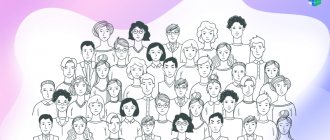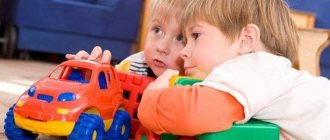“My child doesn’t want to socialize”, “Her boy doesn’t go to kindergarten, he will have problems with socialization” - isn’t it true, you often come across these and similar phrases on forums, and hear them on playgrounds.
They are based on fears and experiences related to the fact that the child will not be able to successfully undergo the process of adaptation in society, will not learn to communicate, will be isolated, expelled from all social groups.
To get rid of fears or, conversely, realize how difficult the situation is, read what socialization is, what it is like and why it is impossible to talk about it as a one-sided process.
In this article:
What is socializationTypes of socializationSocialization as a two-way process
Socialization concept
The concept of socialization is synonymous with the concept of “personality development” in developmental psychology. However, their key difference is that the first involves a view from the side of society, and the second - from the side of the individual himself.
Also, the concept of socialization is synonymous with the concept of “upbringing” in educational psychology, but not in its narrow sense, but in its broad sense, when it is assumed that the whole life, the whole system educates.
Socialization is a complex multi-level process of an individual’s assimilation of social reality. On the one hand, this is a process that helps a person to assimilate everything that surrounds him in social reality, including social norms and rules of society, elements of culture, spiritual values developed by humanity, and therefore helps him subsequently act successfully in this world.
On the other hand, this is also a process that is associated with how exactly this learned experience is further applied by the individual, that is, how the individual, being an active social subject, implements this experience.
The most important factors in the socialization of an individual are the phenomenon of a person being in a group and self-realization through it, as well as his entry into increasingly complex structures of society.
What is socialization
Photo by Anna Tarazevich: Pexels
Look around you - most of the people around you know how to speak, behave adequately in society, consistently and relatively successfully go through certain stages - kindergarten, school, university, work. There are glitches in this process - someone runs away from home, someone commits a crime, but this is rather an exception to the rule.
This consistent development of a person in society is called socialization. Going through each stage, he learns rules, norms, gets used to standards of behavior, learns to communicate or, in other words, socializes.
This process begins in early childhood and continues until the person leaves for another world. He encounters the need to adapt to society in his family, school, at a new job, when moving to another city, or visiting a foreign country.
But what happens if some die falls out of the socialization process? For example, a child will grow up for several years in the forest, like Mowgli children:
- Peter from Germany was discovered in 1725. He was about 10 years old. He died in 1785, by this time he was able to learn to speak only a few words, however, he understood when they addressed him.
- Marie-Angelique Memmie le Blanc from France lived in the forest for the first 10 years of her life, from 1712 (approximately) to 1721. When she was caught, she had the habits of wild animals, but she was able to learn to read and speak.
- Victor of Aveyron was found in 1800 at the age of about 12 years. Until this time, he lived in the forest near various villages. Having lived until he was 40, he never learned to speak.
What is socialization?
- Dina Sanichar is an Indian boy who became the prototype of Mowgli from the work of R. Kipling. Hunters found him in 1867, initially mistaking him for a wild animal. At that time he was about 6 years old, lived with wolves. He lived until 1895, but did not learn to speak.
- John Ssebunya from Uganda was born in the 1980s. At the age of 3, his father killed his mother and the boy ran away from home. It is assumed that by this time he could speak, but very quickly lost the ability to speak and communicate. In 1991, the boy was found. Over time, his speech was restored, and he even learned to play the guitar.
In all these cases, the children experienced problems with communication, could not speak, did not understand other people, were afraid of them, and behaved like small frightened animals. They were unable to socialize and adapt to life in society.
Surely, if you look at the dates, you will say that all this is in the past, and now the process of socialization covers all children and the risk of discovering an unsocialized child is minimal. Moreover, it only appears if the parents are very poor, or the child suffers from some kind of mental illness.
In fact, the situation is more difficult.
Firstly, there are people in the world who, because of their problems, lock their children in basements, rooms, do not allow them to communicate with other children, limit them in everything, not allowing them to develop.
Secondly, ordinary parents prevent children from socializing. Maybe you have a friend who is always busy, just like her husband? They work all the time, communicate with each other via messenger, and take care of the child only when he needs to be fed, washed, and put to bed. The rest of the time the baby is devoted to himself, sees his mother’s back hunched over the computer, and the duty smile of his father as he leaves for work early in the morning.
No one communicates with the baby, doesn’t talk, doesn’t play. As a result, by the age of 3-4, when he needs to go to kindergarten, he does not know how to talk, does not know how to communicate with either children or adults. He lacks personal hygiene skills. At the same time, he is completely healthy and grows up in a prosperous family. What do you think is wrong with the baby in this situation? Of course he is not socialized.
Goals and objectives
The goal of socialization is the formation of a responsible and socially active generation, whose actions are regulated by social norms and public interests. It solves three main problems:
- integrates the individual into society;
- promotes the interaction of people through their assimilation of social roles;
- preserves society through the production and transmission of culture from generation to generation.
Socialization is the result of a person’s mastery and active use of traditional sociocultural heritage while maintaining and developing their individuality.
Phases of personality socialization
Socialization never happens spontaneously. The entire process of socialization occurs in three main stages:
- First stage.
At this phase, mastery and memorization of those norms and values that are inherent in this society occur. As a result, the individual tries to match those around him. - Second phase . At this phase, the individual strives to gain recognition, works on himself in order to influence other people.
- Third stage . At this stage, the individual sets certain goals for himself, tries to achieve them, to realize himself in order to enter society and find his place there.
Only chronological observance of all three stages helps to successfully carry out the process of entering society. All these processes can be considered at the stages of growing up and developing a person’s personality.
Rice. 2. Stages of personality socialization
Mechanisms
Every society has socialization mechanisms through which people convey information about social reality to each other. In sociological terms, there are some “translators” of social experience. These are means that transmit accumulated experience from generation to generation, contributing to the fact that each new generation begins to socialize. Such translators include various sign systems, cultural elements, educational systems, and social roles. Socialization mechanisms are divided into two categories: socio-psychological and socio-pedagogical.
Socio-psychological mechanisms:
- Imprinting is the imprinting of information on the receptor and subconscious levels. More common in infancy.
- Existential pressure - the assimilation of language and norms of behavior at an unconscious level.
- Imitation is following a model, voluntary or involuntary.
- Reflection is an internal dialogue during which a person critically thinks about and then accepts or rejects certain social values.
Social and pedagogical mechanisms:
- Traditional - a person’s assimilation of prevailing stereotypes, which occurs, as a rule, at an unconscious level.
- Institutional - triggered by a person’s interaction with various institutions and organizations.
- Stylized - functions when included in any subcultures.
- Interpersonal - turns on whenever there is contact with persons who are subjectively significant to a person.
The role and functions of socialization institutions in the development of personality
A complex and comprehensive process that contains all areas of human life.
Functions:
- Education and development of social knowledge. Mastering language skills, adopting views, interests, horizons, beliefs.
- Mastery of the totality of human achievements in production, spiritual and social terms, traditions, rules and norms inherent in society.
- Mastering the process of communication, behavior patterns aimed at fulfilling rights and responsibilities.
- Collection and implementation of innovations.
Table: Socialization tasks
| Natural-cultural | The closest approach to a certain level physically and sexually from birth to death. A person needs to achieve the canons inherent in his society - rules of etiquette, kinesthetic gestures, gender-role norms of behavior. |
| Socio-cultural | This group includes cognitive, moral and ethical tasks characteristic of age periodization. |
| Socio-psychological | The process of developing personal self-awareness, choosing one’s position, goals in society, self-affirmation. |
Stages
Socialization is a step-by-step process. At each stage, the above-mentioned translators work differently, and special mechanisms are also included that contribute to better mastery of social reality.
In domestic literature, in particular, in textbooks on social psychology by G. M. Andreeva, three stages of socialization are distinguished: pre-labor, labor and post-labor. At each stage, the emphasis changes, and above all, the relationship between the two sides of socialization - in the sense of mastering experience and in the sense of transferring experience.
The pre-labor stage of socialization corresponds to the period of a person’s life from birth to the start of work. It is further divided into two independent periods:
- Early socialization is inherent in the period of time from birth to entry into school. In developmental psychology, this is the period of early childhood. This stage is characterized by uncritical assimilation of experience and imitation of adults.
- The learning stage covers the entire period of adolescence in a broad sense. It definitely includes time spent at school. But the question of which stage to include the student years has become the subject of debate. After all, many university and technical school students are already starting to work.
The labor stage of socialization corresponds to the period of human maturity, although it should be noted that the demographic boundaries of adulthood are very conditional. It covers the entire period of a person’s active labor activity.
The post-work stage of socialization implies the period of a person’s life after the end of the main work activity. It corresponds to retirement age.
Examples of manifestation
Each social group influences a person differently. For clarity, it is worth considering three different examples:
- Mom and dad teach the child the first words, developing his communication skills.
- At school, the student finds a group of friends, thereby establishing interpersonal relationships.
- On the Internet, a man found paintings by Russian artists that satisfied his spiritual needs.
To better remember the material on the topic, students need to learn the definition of agents of socialization, and then draw up a table and plan in their notebooks, which will indicate representatives of each group.
If you didn’t manage to master what you learned the first time, you need to analyze the table and name the agents that are most difficult to remember. At the end of the repetition, it is worth filling out a diagram indicating which subjects of socialization are included in a specific group.
Kinds
To understand the types of socialization, it is necessary to consider the social institutions corresponding to each stage of development. At the pre-labor stage, institutions facilitate the individual’s entry into the social world and his mastery of this world, its features and laws. During early childhood, the very first institution within which a person begins to master social experience is the family. This is followed by various children's institutions.
During the period of education, the individual begins to interact with the first more or less official representative of society - the school. It is here that he first becomes acquainted with the basics of socialization. Institutions corresponding to this period provide the necessary knowledge about the world around us. Also during this period, the peer group plays a huge role.
Labor stage institutions are enterprises and work collectives. As for the post-labor stage, the question remains open.
Based on the institutional context, two types of socialization are distinguished: primary, associated with the acquisition of experience from a person’s immediate environment, and secondary, associated with the formal environment, the influence of institutions and institutions.
Types of socialization
Every person undergoes an intensive socialization process during childhood. First, the family teaches him to communicate, talk, listen to others, interact with children and adults. Then the mother on the playground teaches the baby to control his behavior and impulses - he forbids taking away toys, screaming, and making trouble.
In kindergarten, a grown-up child is taught how to interact with peers, with elders, and in a team. At school, children learn respect for others, accept norms of behavior, learn to avoid maladaptive forms of behavior, form a positive attitude towards society, and a desire to develop.
However, socialization does not end with school. Throughout life, a person adapts to different groups or situations:
- At work. An employee joins a new team, receives new responsibilities, and learns about new rules that he must follow.
- In a new family. When you get married, you find yourself in a new situation where you need to learn how to interact with your spouse so that, roughly speaking, not kill each other, become a harmonious couple and raise a successful child. In addition, you must build relationships with others no longer as a loner, but as a member of a micro-cell of society - a family.
- During the journey. Here a person encounters a new culture and, at least for a while, must learn to respect it, follow its norms and rules. A simple example: you came to Bulgaria, and there, when they say yes, they wave their heads from side to side, just like in other countries they say “no.”
- When moving. You can move to another city, country, and in each case you will have to learn the norms accepted in this society, learn to follow them, live with them.
- When you go to jail. Unfortunately, as they say, no one is safe from scrip and prison. When entering a penal institution, a person should ideally undergo a process of resocialization, i.e. relearn to live in accordance with the rules accepted in society.
In addition, it makes sense to talk about expected socialization - you expect, think, dream about how you will feel in a new group or situation. This happens when entering university, preparing for a new job, or expecting a baby.
Spheres
The main areas in which an individual masters social connections are activity, communication and self-awareness.
In the process of activity, a person’s horizons regarding various types of activities expand. Next, this new information is structured, and then the person focuses on a certain type of activity as the main one, the main one at this stage. That is, a hierarchy is built, comprehension occurs, and the central type of activity is determined.
Communication expands and enriches a person’s connections with the public. Firstly, there is a deepening of forms of communication, that is, a transition from monologue to dialogical communication. What does it mean? The fact that a person learns to decenter, to take into account the point of view of another as an equal communication partner. An example of monologue communication is the catchphrase and half-joking expression: “There are two points of view on this matter - mine and the wrong one.” Secondly, the circle of contacts increases. For example, with the transition from school to college, the process of mastering a new environment begins.
As a person masters new types of activities and new forms of communication, he develops his own self-awareness, which is understood as a person’s ability in general to distinguish himself from others, the ability to recognize himself as “I” and, along the way, develop some kind of system of ideas about life, about people, about the world around us. Self-awareness has three main components:
- Cognitive self is knowledge of some of one’s own characteristics and ideas.
- Emotional Self - is associated with a general assessment of oneself.
- Behavioral self is an understanding of what style of behavior, what modes of behavior are characteristic of a person and which ones he chooses.
As socialization occurs, self-awareness grows, that is, understanding oneself in this world, one’s capabilities, one’s preferred strategies of behavior. It is very important to note here that as self-awareness grows, a person learns to make decisions and choices.
Making decisions is a very important moment of socialization, because only adequate decisions allow a person to subsequently perform fairly adequate actions in the world around him.
Taken together, activity, communication and the development of self-awareness represent a process during which a person masters the expanding reality around him. It begins to unfold before him in all its diversity and in all its complexities.
Personality Formation Tools
To create a full-fledged personality, different tools and methods of socialization are used.
Fixed assets:
- speech skills;
- social rules and values, skills and abilities;
- position and role in society.
Mechanisms of socialization according to G. Tarde
| Repetition | Children tend to imitate adults, and subordinates tend to imitate leaders. All fashion trends, rituals and traditions are determined by the law of repetition. |
| Opposition | The mental confrontation of a person who needs to choose one model of behavior from several. |
| Device | The ability to make mutual concessions and reach agreement in the adaptation process. |
Creating an absolutely identical personality is not a task of socialization, since society implies the individual's manifestation of characteristics that help him to be self-realized.
Features of socialization of children with disabilities
The socialization of children with disabilities - disabilities - provides for their right to diagnosis, special programs of psychocorrectional work, organizational and methodological assistance to families, differentiated and individual education. For children with special educational needs the following are created:
- Specialized preschool educational institutions, schools or correctional classes in regular schools.
- Health educational institutions of sanatorium type.
- Special correctional educational institutions.
- Educational institutions for children in need of psychological, pedagogical and medical and social assistance.
- Educational institutions of primary vocational education.
Opportunities for obtaining secondary vocational and higher vocational education are being created for children with disabilities. For this purpose, special educational institutions are created, and various forms of integration are provided for in general institutions.
Despite this, the problem of socialization of children and adolescents with disabilities continues to remain relevant. The question of their integration into the society of “healthy” peers raises a lot of controversy and discussion.
Features of youth socialization
Young people are the most mobile part of society. This is the group that is most receptive to new trends, phenomena, knowledge and ideas about the world. But it is not sufficiently adapted to its new social conditions, and therefore is more easily influenced and manipulated. It has not yet formed stable views and beliefs, and both political and social orientation are difficult.
Young people also differ from other groups of society in that they are involved in almost all social processes, either directly or indirectly, for example, through their family.
This socio-demographic group includes people aged 16 to 30 years. These years include such important events as obtaining secondary and higher education, choosing and mastering a profession, creating your own family and having children. During this period, serious difficulties at the stage of life start are acutely felt. First of all, this concerns employment issues, housing and material problems.
At the present stage, the problems of psychological adaptation of young people are becoming more complex; the mechanisms for their involvement in the system of social relationships are complicated. Therefore, in addition to general education institutions, special youth socialization centers (YSCs) are being created. The main directions of their activities, as a rule, are related to the organization of socio-cultural and leisure events, the provision of information and consulting services, and the promotion of a healthy lifestyle. Youth is the main resource of society, its future. Her spiritual values and views, moral character and vitality are very important.
Socialization factors
The formation and development of an individual is influenced by many factors at different levels.
Socialization structure - table
| Mega | Macro | Mesofactors – intermediate | Micro |
| The universe and the world in general. To varying degrees, through other factors they influence the socialization of the entire population. | Country, ethnicity, society, political and economic situation. | Type and place of residence, belonging to subcultures. | Family, immediate environment. Peers, educational institutions, religious, government, public organizations. |
Features of socialization of older people
Recently, sociologists have begun to pay closer attention to the study of the socialization of older people. The transition to the post-work stage, adaptation to a new way of life does not necessarily imply a process of growth. Personal development may stop or even reverse, for example, due to a decrease in a person’s physical and psychological capabilities. Another difficulty is that for older people social roles are not clearly defined.
The topic of socialization of older people among researchers of this process is currently causing heated discussions, the main positions of which are completely opposite. According to one of them, the concept of socialization is not applicable to the period of life when all social functions of a person are curtailed. An extreme expression of this point of view is the idea of "desocialization" following the working stage.
According to another, a completely new approach to understanding the psychological essence of old age is needed. Quite a lot of experimental research has already been carried out confirming the continued social activity of older people. Only its type changes during this period. And their contribution to the reproduction of social experience is recognized as valuable and significant.
Interesting examples of socialization of people over 60
Vladimir Yakovlev, as part of his project “The Age of Happiness,” in the book “Wanted and Could,” highlights the stories of women who, through their personal example, proved that it is never too late to start making your incredible dreams come true. The motto of the book: “If it’s possible at 60, then it’s possible at 30.” Here are some inspiring examples of socialization in old age.
Ruth Flowers decided to become a club DJ at the age of 68. At the age of 73, under the pseudonym “Mami Rock,” she already gave several concerts a month, performed in the best clubs in the world and practically lived on airplanes, flying from one end of the world to the other.
Jacqueline Murdoch dreamed of working as a fashion model in her youth. At 82 years old - in the summer of 2012 - she became famous throughout the world, becoming the face of the Lanvin brand.
Evgenia Stepanova, upon reaching 60 years old, decided to start a career as a professional athlete. By the age of 74, she had achieved significant success in this field. Thanks to the large number of competitions for older athletes around the world, she has plenty of opportunities to ride, compete and win.








